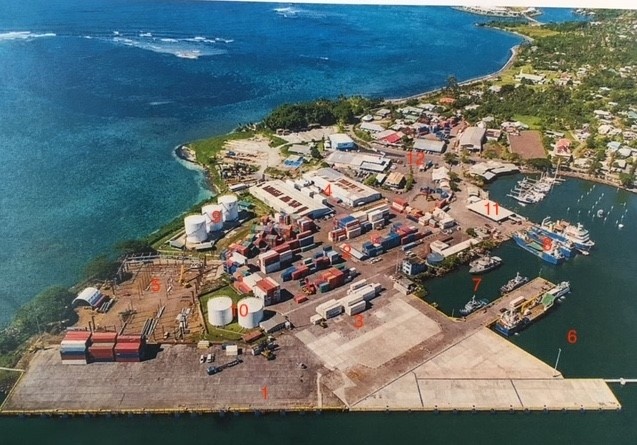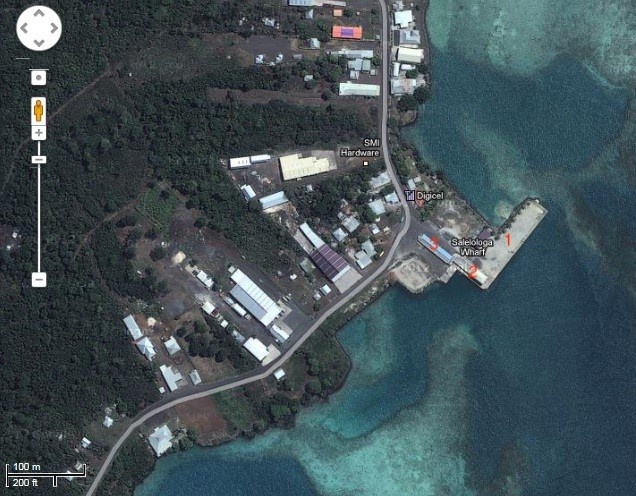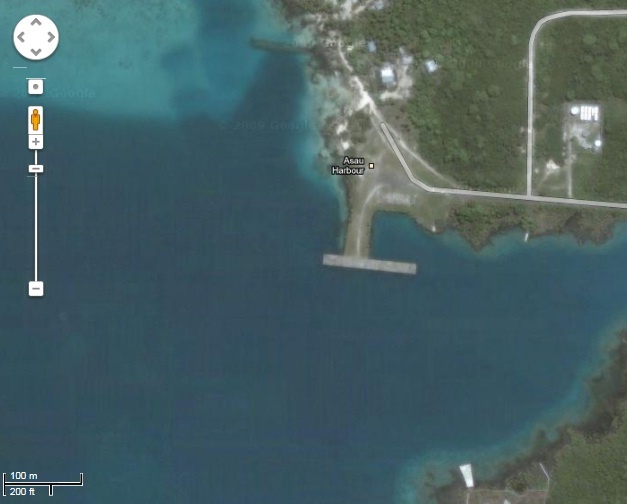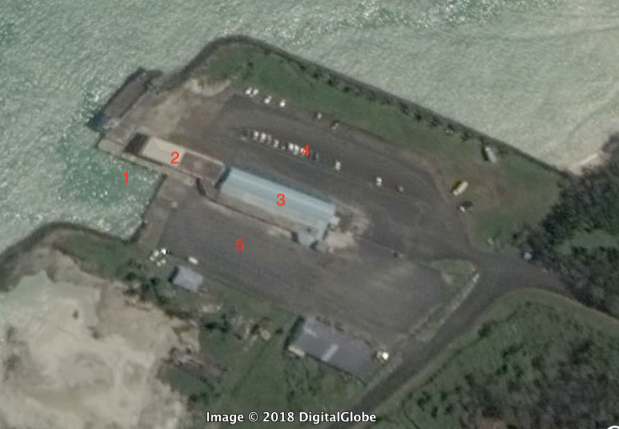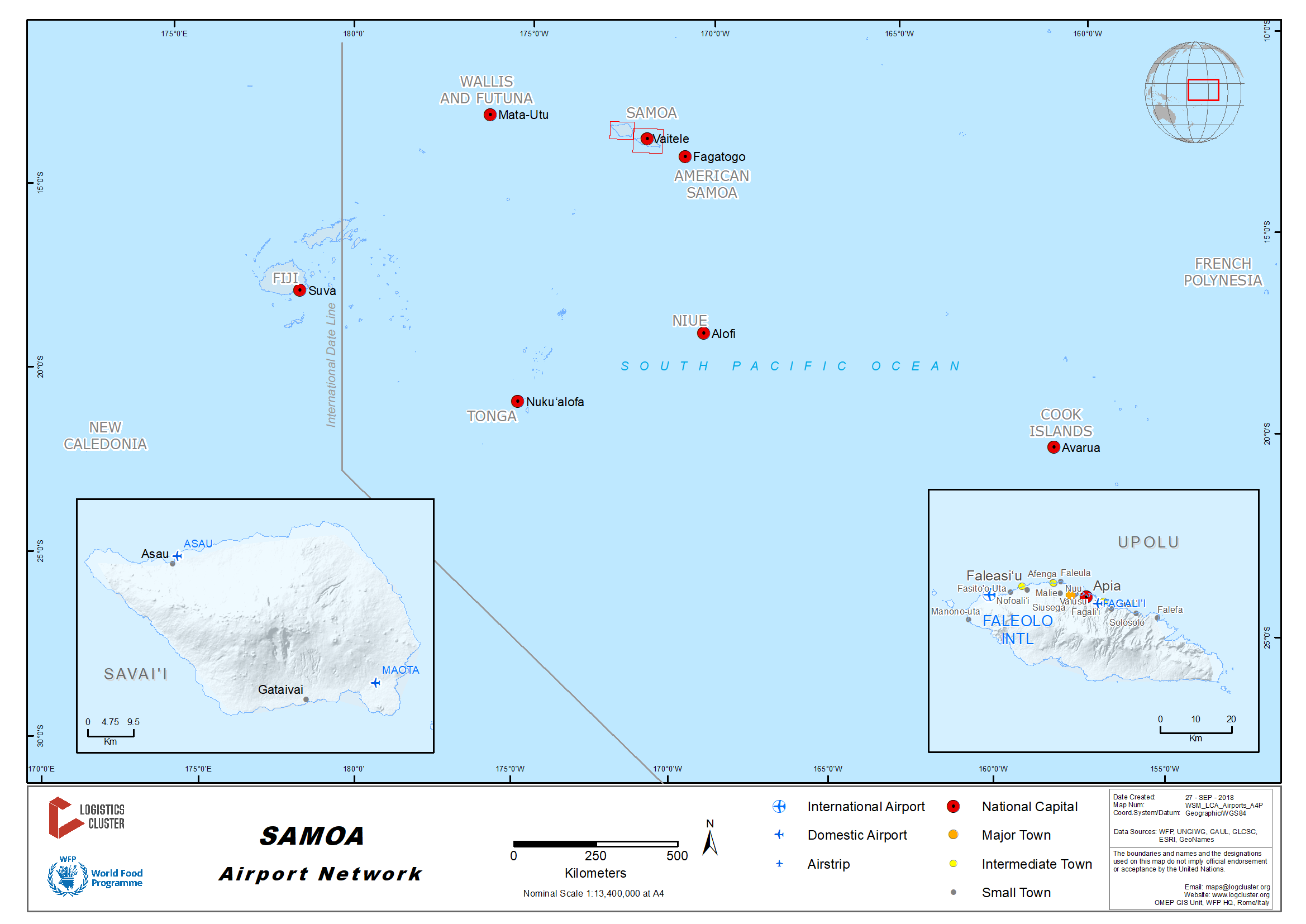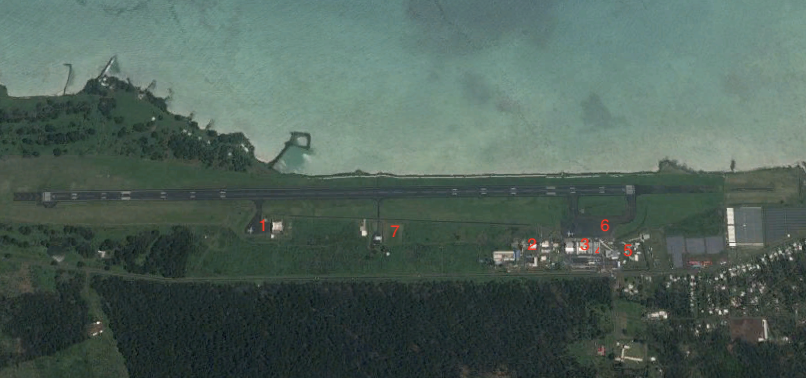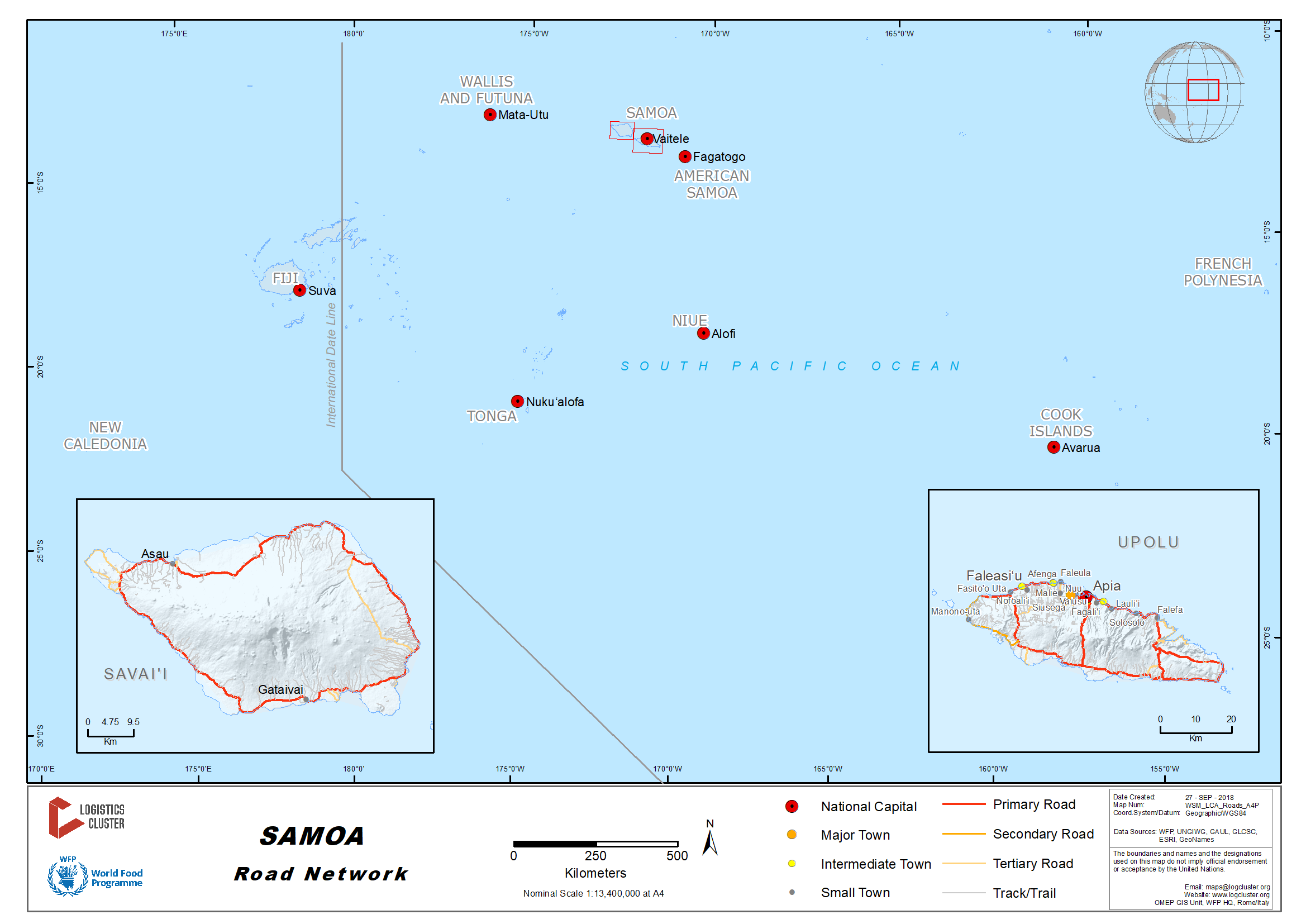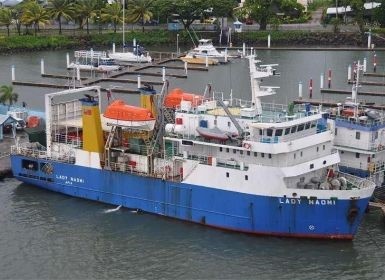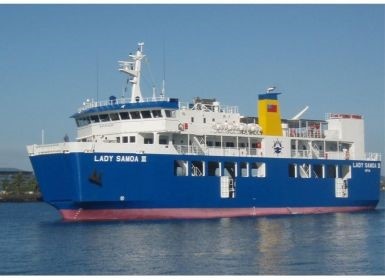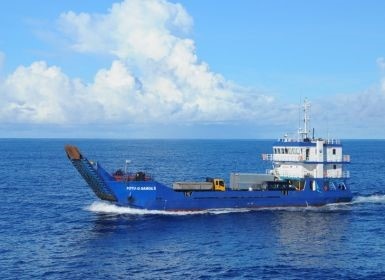2 Samoa Logistics Infrastructure
2.1 Samoa Port Assessment
There are 6 ports in Samoa – 4 ports located on the main island of Upolo and 2 ports located on the island of Savaii.
The primary international port is Apia at Matauta, which provides facilities for international freight movements, including container ships, bulk petroleum products, cruise and other vessel arrivals, as well as some inter-island ferry services. Apia Port also handles around 5,000 mt per annum of the domestic inshore fishing industry catch.
Other ports are used only as domestic (inter-island) ferry terminals, or rarely, if at all. Whilst there are long-term plans to develop a port for cruise ships and yachts at Fagamalo Bay, a commercial port at Vaiusu Bay and the redevelopment of the port at Asau, there is no immediate funding plan for these projects.
2.1.1 Samoa Port of Apia
Key port information can also be found at: Website of the Maritime Database on the Port of Apia
Port Overview
Apia Port is a solely
commercial port, handling about 97% of all foreign trade cargoes
for the country, and is regarded as the lifeline of a country
largely dependent upon imports and transportation by
sea.
The Portis connected with Southern Pacific countries such as
New Zealand and Australia, and Northern Pacific countries including
Japan and the United States, as well as Europe.
Neighbouring island countries are served with container and
Ro-Ro ships, and other irregular services are provided by
small cargo vessel and oil tankers. Passenger cruise liners
cruising the South Pacific call at Apia Port several times a
year. Apia Port also
handles around 5,000 mt per annum of the domestic inshore fishing
industry catch.
The Samoa maritime sector has set high standards and is widely regarded to be a leader in the maritime sector in the region. Fixed infrastructure is generally in good condition, appropriate for needs, and with capacity to absorb further growth, however, other than mobile cranes operated by the stevedoring companies, there are no dockside cranes. This means that loading and unloading facilities for containers are generally limited to using ships cranes at dockside, and moving containers to storage areas using trucks, trailers and container lifters. The port area is secure and held to ISPS standards.
The Samoa Ports Authority (SPA) is responsible for the management of the port; it is a government-controlled entity, financially stable and complies with relevant international standards.
Key port information may also be found at: http://www.maritime-database.com
|
Port Location and Contact |
|
|---|---|
|
Country |
Samoa |
|
Province or District |
Apia, Upolu Island |
|
Nearest Town or City with Distance from Port |
Apia 0.5 Km |
|
Port's Complete Name |
Apia Port |
|
Latitude |
Latitude: 13° 49′ 42″ S |
|
Longitude |
Longitude: 171° 45′ 45″ W |
|
Managing Company or Port Authority |
Samoa Ports Authority |
|
Management Contact Person |
Taulapapa M Lealaiauloto Tafai Toilolo |
|
Nearest Airport and Airlines with Frequent International Arrivals/Departures |
Faleolo International Airport Air NZ, Samoa Airways, Virgin Australia |
Port Picture
1 Main berth 2 Container storage 3 Refrigerated container storage
4 Warehouse storage 5 Proposed cable storage 6 Fishing boats & small cargoes
7 Tug & police berthing 8 SSC ferries berthing 9 ?
10 Tanks to be removed to provide additional container storage 11 SSC operations area
12 Port vehicle entrance
Description and Contacts of Key Companies
Oversight for operations within the Port rests with the Samoa Ports Authority (SPA). Samoa Shipping Corporation (SSC) operates Ro-Ro ferries and landing craft. Stevedoring is carried out by 3 companies contracted to SPA: Bethem Brothers Enterprises (BBE), Pacific Forum Line (PFL) and Apia Stevedoring Ltd (ASL). The main transporters responsible for moving containers out of the Port are Silva Transport Ltd, Ah Liki (BlueBird Transport) and Bethem Brothers Enterprises (BBE).
For more information on port contacts, please see the following link:
4.3 Samoa Port and Waterways Company Contact List
Port Performance
Channel draft is 12m but max draft at the wharf is 10.5m. The main limiting factor to performance is the port’s exposure to swells from the open sea at certain times of the year. This can cause disruption to loading and unloading and berthing. It can also result in vessels having to leave the port until swells subside. The port is not congested and there is generally no waiting time between arrival and berthing. Vessels should give 48 hours notice of arrival to ensure quick berthing and turnaround. The port is efficiently run, and turnaround times are generally quick with abundant stevedore labour available. There is no priority for humanitarian cargo under normal circumstances, but this shall be amended in emergency situations.
|
Seasonal Constraints |
||
|---|---|---|
|
Occurs |
Time Frame |
|
|
Rainy Season |
No |
N/a |
|
Major Import Campaigns |
No |
N/a |
|
Other Comments |
‘Swell’ season occurs from October to March. Sea swells in the port may cause delays to berthing, or require removal of ships from the port (up to 4 days a week). |
|
|
Handling Figures for 2016 |
|
|---|---|
|
Vessel Calls |
532 |
|
Container Traffic (TEUs) |
32,000 |
|
Handling Figures Bulk and Break Bulk for 2016 |
|
|---|---|
|
Bulk (mt) Includes container volume |
462,000 |
|
Break bulk (mt) |
85,000 |
Berthing Specifications
There is only one berth.
|
Type of Berth |
Quantity |
Length (m) |
Maximum Draft (m) |
Comments |
|---|---|---|---|---|
|
Conventional & Container Berth |
1 |
305 m |
10.5 |
One berth only |
|
Silo Berth |
N/a |
|||
|
Berthing Tugs |
2 |
28 m |
2.5 m |
Gross 121 MT each |
|
Water Barges |
N/a |
|||
|
Other Comments |
Fuel discharges to tank farm at main terminal LPG discharged from mooring |
|||
General Cargo Handling Berths
|
Cargo Type |
Berth Identification |
|---|---|
|
Imports - Bagged Cargo |
Main berth |
|
Exports - Bagged Cargo |
Main berth |
|
Imports and Exports - RoRo |
Main berth |
|
Other Imports |
Main berth |
Port Handling Equipment
Contracted stevedoring companies manage the port equipment. There is limited equipment available with dockside container loading done by ship’s crane. There are 2 mobile cranes; small and large forklifts in the container storage stacking area.
|
Equipment |
Available |
Total Quantity and Capacity Available |
Comments on Current Condition and Actual Usage |
|---|---|---|---|
|
Dockside Crane |
No |
||
|
Container Gantries |
No |
||
|
Mobile Cranes |
Yes |
1 x 50 mt 2 x 30 mt |
Good |
|
Reachstacker |
No |
|
|
|
RoRo Tugmaster (with Trailer) |
No |
||
|
Grain Elevator with Bagging Machines |
No |
||
|
Transtainer |
No |
||
|
Forklifts |
Yes |
4 x 15 mt 7 x 30 mt |
Owned by stevedoring companies |
Container Facilities
Containers are stacked on asphalt area, are well-organised and tidy.
|
Facilities |
20 ft |
40 ft |
|---|---|---|
|
Container Facilities Available |
2,800m2 area for stacking
|
|
|
Container Freight Station (CFS) |
N/a |
N/a |
|
Refrigerated Container Stations |
N/a |
N/a |
|
Other Capacity Details |
||
|
Daily Take Off Capacity |
150 - 200 |
|
|
Number of Reefer Stations |
150 |
|
|
Emergency Take-off Capacity |
400 in a 24 hour period |
|
|
Off take Capacity of Gang Shift |
150 - 200 |
|
Customs Guidance
Customs offices are located adjacent to the port. Customs office hours are 0900 – 1500, however, officials are available for all arrivals. Port authorities should be notified 48 hours prior to vessel arrivals to ensure efficient turnaround and most vessels will be cleared in a few hours, unless there is risk of bio-security in which case vessels will be required to anchor offshore so that customs inspections can be completed before vessels enter the port.
For more information on customs in Samoa, please see the following link:
Terminal Information
Multipurpose Terminal
There is a single berth available for all unloading, Roll on Roll off, containerised and bulk palletised cargo.
Grain and Bulk Handling
There are no facilities available for handling grain at the port.
Main Storage Terminal
There are two warehouse facilities within the port area, approximately 2,000 m2 each; these are generally 80% full. Facilities are basic but secure. Of the two available facilities, 50% of one is leased to a fishing company and that space is fully utilised by them.
|
Storage Type |
Number of Storage Facilities |
Area (m2) |
|---|---|---|
|
Bagged Cargo |
N/a |
|
|
Refrigerated Cargo |
N/a |
|
|
General Cargo |
2 |
3000m2 |
Stevedoring
Three private companies carry out stevedoring activities. There is a plentiful supply of labour available locally. The majority of cargo arrives containerised and is loaded directly onto trucks to be either stacked in the port area, or is transported directly out of the port.
Hinterland Information
Private transport companies move cargo items from the port. There is an ample supply of well-maintained trucks with side lifting capability to handle 20’ and 40’ containers, and the road network allows efficient delivery of containers to nearby Apia and the hinterland. Similarly, there is a sufficient local supply of flatbed trucks for the carriage of bulk and break bulk cargo in either loose, or palletised form.
Port Security
The port is well-fenced, and security is present within this secured area and at the entry point 24/7. All traffic is monitored entering and exiting. There is a manned police post inside the port compound. New Zealand and Australian safety codes are the standard, and are monitored by port authorities. There are no obvious areas of security concerns.
|
Security |
|
|---|---|
|
ISPS Compliant |
Yes |
|
Current ISPS Level |
1 |
|
Police Boats |
Yes (1) |
|
Fire Engines |
Not on port site. Distance to Apia Fire Station is approximately 0.5 Km |
2.1.2 Samoa Port of Saleologa
Port Overview
Salelologa is a village district on the eastern end of Savai'i Island. Salelologa wharf is the main port of entry into the island, and is the only ferry terminal on Savai'i.
The inter-island passenger and vehicle ferries operate in the Apolima Strait between Salelologa and Mulifanua wharf (at the North West corner of Upolu), and operate 7 days a week during the day. Ferry arrivals and departures are usually every two hours. A one-way trip takes about 90 minutes. The ferries are managed by the government/private sector joint venture company Samoa Shipping Corporation (SSC) that also manages the Port. There are no facilities at the port other than a passenger terminal, ticket office and roll on roll off wharf.
There has been discussion around transferring port management to the Samoa Ports Authority, however no definite timelines for this have been set.
Port website: http://www.samoashipping.com/destinations/salelologa
Key port information may also be found at: http://www.maritime-database.com
|
Port Location and Contact |
|
|---|---|
|
Country |
Samoa |
|
Province or District |
Saval’il Island |
|
Nearest Town or City with Distance from Port |
Salelologa (town at the port) |
|
Port's Complete Name |
Port of Salelologa |
|
Latitude |
-13.73778 |
|
Longitude |
-172.2206 |
|
Managing Company or Port Authority |
Samoa Shipping Company (SSC) |
|
Management Contact Person |
Pipi Ioane Fomai (pipi@samoashipping.com) |
|
Nearest Airport and Airlines with Frequent International Arrivals/Departures |
Faleolo International Airport Air NZ, Samoa Airlines, Virgin Australia |
Port Picture
1 Disused wharf (in disrepair) 2 SSC offices 3 Terminal building
Description and Contacts of Key Companies
Samoa Shipping Corporation is responsible for the port, facilities and operating the ferry service.
For more information on port contacts, please see the following link: 4.3 Port and Waterways Companies Contact List
Port Performance
The port is used solely for loading and offloading passengers and vehicles using the domestic inter-island ferry service. There are no facilities for any cargo handling.
|
Seasonal Constraints |
||
|---|---|---|
|
Occurs |
Time Frame |
|
|
Rainy Season |
No |
|
|
Major Import Campaigns |
No |
|
|
Other Comments |
|
|
|
Handling Figures for N/a |
|
|---|---|
|
Vessel Calls |
N/a |
|
Container Traffic (TEUs) |
N/a |
|
Handling Figures Bulk and Break Bulk for N/a |
|
|---|---|
|
Bulk (mt) |
N/a |
|
Break bulk (mt) |
N/a |
Berthing Specifications
|
Type of Berth |
Quantity |
Length (m) |
Maximum Draft (m) |
Comments |
|---|---|---|---|---|
|
Conventional Berth |
1 |
45m |
6m |
Used for domestic ferry service only |
|
Container Berth |
N/a |
|
||
|
Silo Berth |
N/a |
|
||
|
Berthing Tugs |
N/a |
|
||
|
Water Barges |
N/a |
|
General Cargo Handling Berths
|
Cargo Type |
Berth Identification |
|---|---|
|
Imports - Bagged Cargo |
N/a |
|
Exports - Bagged Cargo |
N/a |
|
Imports and Exports - RoRo |
N/a |
|
Other Imports |
N/a |
Port Handling Equipment
There is no handling equipment.
|
Equipment |
Available |
Total Quantity and Capacity Available |
Comments on Current Condition and Actual Usage |
|---|---|---|---|
|
Dockside Crane |
No |
||
|
Container Gantries |
No |
||
|
Mobile Cranes |
No |
||
|
Reachstacker |
No |
||
|
RoRo Tugmaster (with Trailer) |
No |
||
|
Grain Elevator with Bagging Machines |
No |
||
|
Transtainer |
No |
||
|
Forklifts |
No |
Container Facilities
There are no container facilities.
|
Facilities |
20 ft |
40 ft |
|---|---|---|
|
Container Facilities Available |
N/a |
N/a |
|
Container Freight Station (CFS) |
N/a |
N/a |
|
Refrigerated Container Stations |
N/a |
N/a |
|
Other Capacity Details |
N/a |
N/a |
|
Daily Take Off Capacity |
N/a |
N/a |
|
Number of Reefer Stations |
N/a |
N/a |
|
Emergency Take-off Capacity |
N/a |
N/a |
|
Off take Capacity of Gang Shift |
N/a |
N/a |
Customs Guidance
There are no customs services.
For more information on customs in Samoa, please see the following link: 1.3 Customs Information
Stevedoring
There are no stevedoring activities
Hinterland Information
There is no requirement for hinterland transport, however there are abundant flat deck trucks (5mt) available on the island of Savai’i if required.
Port Security
There is no permanent port security.
|
Security |
|
|---|---|
|
ISPS Compliant |
No |
|
Current ISPS Level |
N/a |
|
Police Boats |
No |
|
Fire Engines |
No |
2.1.3 Samoa Port of Asau
Port Overview
Constructed in the 1960s for lumbering operations, Asau is situated on the North West coast of Savai'i Island. The harbour and small wharf are seldom used now. The mouth of Asau Harbour is blocked by a coral reef. Draft is around 6m, there is a 2.5m draft restriction. Channel width is around 40m. There are plans - though currently no funding - to complete dredging and make Asau a secondary port for fishing fleet and small container cargo (mainly fish).
Key port information may also be found at: http://www.maritime-database.com
|
Port Location and Contact |
|
|---|---|
|
Country |
Samoa |
|
Province or District |
Savai’il Island, Vaisigano district |
|
Nearest Town or City with Distance from Port |
Asau (village at port) |
|
Port's Complete Name |
Port of Asua |
|
Latitude |
-13.51939 |
|
Longitude |
-172.6372 |
|
Managing Company or Port Authority |
Samoa Ports Authority |
|
Management Contact Person |
Taulapapa M Lealaiauloto Tafai Toilolo |
|
Nearest Airport and Airlines with Frequent International Arrivals/Departures |
Faleolo International Airport Air NZ, Virgin Australia, Samoa Airways |
Port Picture
Description and Contacts of Key Companies
The port is not used as a result of the shallow and narrow channel resulting from sand and coral drift. Consequently there are no facilities at the port other than the wharf itself.
For more information on port contacts, please see the following link: 4.4 Port and Waterways Companies Contact List
Port Performance
The port is not used, because of the shallow and narrow channel resulting from sand and coral drift. Consequently there are no facilities at the port other than the wharf itself.
|
Seasonal Constraints |
||
|---|---|---|
|
Occurs |
Time Frame |
|
|
Rainy Season |
No |
|
|
Major Import Campaigns |
No |
|
|
Other Comments |
The port is not used because of the shallow and narrow channel resulting from sand and coral drift. Consequently there are no facilities at the port other than the wharf itself. |
|
|
Handling Figures |
|
|---|---|
|
Vessel Calls |
N/a |
|
Container Traffic (TEUs) |
N/a |
|
Handling Figures Bulk and Break Bulk |
|
|---|---|
|
Bulk (MT) |
N/a |
|
Break bulk (MT) |
N/a |
Berthing Specifications
|
Type of Berth |
Quantity |
Length (m) |
Maximum Draft (m) |
Comments |
|---|---|---|---|---|
|
Conventional Berth |
1 |
110 |
12 |
Channel width and draft are limiting factors |
|
Container Berth |
|
|||
|
Silo Berth |
N/a |
|
||
|
Berthing Tugs |
N/a |
|
||
|
Water Barges |
N/a |
|
General Cargo Handling Berths
|
Cargo Type |
Berth Identification |
|---|---|
|
Imports - Bagged Cargo |
N/a |
|
Exports - Bagged Cargo |
N/a |
|
Imports and Exports - RoRo |
N/a |
|
Other Imports |
N/a |
Port Handling Equipment
The Samoa Ports Authority manages the port, however the port is not used as a result of the shallow and narrow channel resulting from sand and coral drift. Consequently there are no facilities at the port other than the wharf itself.
|
Equipment |
Available |
Total Quantity and Capacity Available |
Comments on Current Condition and Actual Usage |
|---|---|---|---|
|
Dockside Crane |
N/a |
||
|
Container Gantries |
N/a |
||
|
Mobile Cranes |
N/a |
||
|
Reachstacker |
N/a |
||
|
RoRo Tugmaster (with Trailer) |
N/a |
||
|
Grain Elevator with Bagging Machines |
N/a |
||
|
Transtainer |
N/a |
||
|
Forklifts |
N/a |
Container Facilities
|
Facilities |
20 ft |
40 ft |
|---|---|---|
|
Container Facilities Available |
N/a |
N/a |
|
Container Freight Station (CFS) |
N/a |
N/a |
|
Refrigerated Container Stations |
N/a |
N/a |
|
Other Capacity Details |
N/a |
N/a |
|
Daily Take Off Capacity |
N/a |
N/a |
|
Number of Reefer Stations |
N/a |
N/a |
|
Emergency Take-off Capacity |
N/a |
N/a |
|
Off take Capacity of Gang Shift |
N/a |
N/a |
Customs Guidance
Customs is not present at the port.
For more information on customs in Samoa, please see the following link: 1.3 Customs Information
Stevedoring
The port is not used because of the shallow and narrow channel resulting from sand and coral drift. Consequently there are no facilities at the port other than the wharf.
Hinterland Information
N/a
Port Security
There is no security at the port and no fencing.
|
Security |
|
|---|---|
|
ISPS Compliant |
N/a |
|
Current ISPS Level |
N/a |
|
Police Boats |
N/a |
|
Fire Engines |
N/a |
2.1.4 Samoa Port of Mulifanua
Port Overview
Mulifanua is a village on the north-western tip of the island of Upolu. Mulifanua wharf is the main ferry terminal for inter-island vehicle and passenger travel across the Apolima Strait between Upolu and the island of Savai'i. The government's joint venture company Samoa Shipping Corporation (SSC) operates the ferry service, seven days a week, between Mulifanua and Salelologa at the east end of Savai'i Island. A one-way trip between the two islands takes about 90 minutes. The ferry usually runs every two hours during the day.
SSC is also responsible for management of the port . The port is utilised solely as a ferry terminal, and as such there are no facilities at the port other than a passenger terminal, ticket office and roll on roll off wharf.
In 2018 Mulifanau had an upgrade completed on the passenger and bus terminal. As a result of drifting sand, dredging operation is being planned to maintain channel width and depth.
Port website: http://www.samoashipping.com/destinations/mulifanua
Key port information may also be found at: http://www.maritime-database.com
|
Port Location and Contact |
|
|---|---|
|
Country |
Samoa |
|
Province or District |
Upolu Island, Aiga-i-le-Tai district |
|
Nearest Town or City with Distance from Port |
Mulifanau (Village at the port) |
|
Port's Complete Name |
Port of Mulifanau |
|
Latitude |
-13.830154˚ |
|
Longitude |
-172.036398˚ |
|
Managing Company or Port Authority |
Samoa Shipping Company |
|
Management Contact Person |
Pipi Ioane Fomai (pipi@samoashipping.com) |
|
Nearest Airport and Airlines with Frequent International Arrivals/Departures |
Faleolo International Airport Air NZ, Virgin Australia, Samoa Airlines. |
Port Picture
1 Ro-Ro wharf 2 SSC Offices 3 Ferry terminal buildings 4 Car Park
5 Loading/unloading area for ferry
Description and Contacts of Key Companies
Samoa Shipping Corporation (SSC) manages the port. It is used for Ro-Ro operations for the inter-island ferry service also managed by SSC. There are no other facilities available and no other companies present at the port.
For more information on port contacts, please see the following link: 4.3 Port and Waterways Companies Contact List
Port Performance
Samoa Shipping Corporation (SSC) manages the port. It is used for Ro-Ro operations for the inter-island ferry service also managed by SSC. There are no other facilities available and no other companies present within the port.
|
Seasonal Constraints |
||
|---|---|---|
|
Occurs |
Time Frame |
|
|
Rainy Season |
No |
N/a |
|
Major Import Campaigns |
No |
N/a |
|
Other Comments |
|
|
|
Handling Figures |
|
|---|---|
|
Vessel Calls |
N/a |
|
Container Traffic (TEUs) |
N/a |
|
Handling Figures Bulk and Break Bulk |
|
|---|---|
|
Bulk (MT) |
N/a |
|
Break bulk (MT) |
N/a |
Berthing Specifications
|
Type of Berth |
Quantity |
Length (m) |
Maximum Draft (m) |
Comments |
|---|---|---|---|---|
|
Conventional Berth |
1 |
45m |
5m |
|
|
Container Berth |
N/a |
|
||
|
Silo Berth |
N/a |
|
||
|
Berthing Tugs |
N/a |
|
||
|
Water Barges |
N/a |
|
General Cargo Handling Berths
|
Cargo Type |
Berth Identification |
|---|---|
|
Imports - Bagged Cargo |
N/a |
|
Exports - Bagged Cargo |
N/a |
|
Imports and Exports - RoRo |
N/a |
|
Other Imports |
N/a |
Port Handling Equipment
Samoa Shipping Corporation (SSC) a government joint venture, manages the port. It is used for Ro-Ro operations for the inter-island ferry service also managed by SSC. There are no other facilities available and no other companies present within the port.
|
Equipment |
Available |
Total Quantity and Capacity Available |
Comments on Current Condition and Actual Usage |
|---|---|---|---|
|
Dockside Crane |
No |
||
|
Container Gantries |
No |
||
|
Mobile Cranes |
No |
||
|
Reachstacker |
No |
||
|
RoRo Tugmaster (with Trailer) |
No |
||
|
Grain Elevator with Bagging Machines |
No |
||
|
Transtainer |
No |
||
|
Forklifts |
No |
Container Facilities
|
Facilities |
20 ft |
40 ft |
|---|---|---|
|
Container Facilities Available |
N/a |
N/a |
|
Container Freight Station (CFS) |
N/a |
N/a |
|
Refrigerated Container Stations |
N/a |
N/a |
|
Other Capacity Details |
N/a |
N/a |
|
Daily Take Off Capacity |
N/a |
N/a |
|
Number of Reefer Stations |
N/a |
N/a |
|
Emergency Take-off Capacity |
N/a |
N/a |
|
Off take Capacity of Gang Shift |
N/a |
N/a |
Customs Guidance
There are no customs services available at this port
For more information on customs in Samoa, please see the following link: 1.3 Customs Information
Terminal Information
MAIN STORAGE TERMINAL
There are no storage facilities available at this port.
|
Storage Type |
Number of Storage Facilities |
Area (m2) |
|---|---|---|
|
Bagged Cargo |
N/a |
N/a |
|
Refrigerated Cargo |
N/a |
N/a |
|
General Cargo |
N/a |
N/a |
Port Security
There is local security present.
|
Security |
|
|---|---|
|
ISPS Compliant |
No |
|
Current ISPS Level |
N/a |
|
Police Boats |
No |
|
Fire Engines |
No |
2.2 Samoa Aviation
Key airport information may also be found at: http://worldaerodata.com/wad.cgi?id=WS24703
National Airlines
Samoa Airways, Samoa’s national air carrier, is licensed and certified by the Ministry to operate scheduled and non-scheduled air services. Flights to Australia and New Zealand depart from Faleolo Airport and to American Samoa from Fangali’I Airport.
Talofa Airways operates flights to American Samoa and Tonga from Fagali’I Airport.
Foreign Air Carriers
Air New Zealand operates B767 services to Los Angeles via Samoa and Airbus A320 services to/from Auckland alternating with the B767.
Air Pacific operates twice weekly, scheduled flights to/from Nadi, Fiji, utilizing B737-800, with a weekly flight through Samoa to Honolulu.
Virgin Australia operates flights to Australia.
Three airports, Faleolo, Maota and Asau, are managed and operated by the Samoa Airport Authority (SAA) with Polynesian Holdings Limited operating Fagali’I airport. All the airports are certified by the Ministry in accordance with their intended usage by the airport operators.
Faleolo International Airport caters for all civil aircraft up to B747 size with its 3000m runway, and is compliant with CAR Pt 139 and ICAO Annex 14 Standards. The airport has a Cat I ILS for Runway 08.
There is a proposal to construct a new national airport serving Pago Pago at TIAVEA. It is anticipated work may start on this in 2019. It is planned that it will take aircraft of C130 and lighter.
For more information on government agency and airport company contact information, please see the following links: 4.1 Government Contact List and 4.5 Airport Companies Contact List
Procedures for Foreign Registered Aircraft
The Ministry of Works, Transport & Infrastructure is the appropriate authority for issues regarding Civil Aviation in Samoa. In terms of registration of foreign aircrafts, this may be complex for the UN, but it is recommended that for any humanitarian or emergency responses providing assistance to Samoa, this is to be communicated to the Ministry of Foreign Affairs and Trade who then deal with issuing Diplomatic Clearances for such purposes.
For all the humanitarian flights, permission from the Ministry of Foreign Affairs is to be obtained to land (international landing) or to fly over the territory of Samoa.
The following documentation will need to be attached:
- Air operator certificate
- Certificate of aircraft registration
- Aircraft radio license
- Aircrew documents (original to be presented)
- Contract agreement for the intended operation in Samoa
At the time of inspection, original copies of the above documents will be verified, as well as the operations manual, maintenance control manual, etc.
Non-scheduled flights intending to land at a Samoan airport shall request permission from the Secretary for Transport/CEO, Ministry of Works, Transport & Infrastructure (MWTI), Private Bag, Samoa, 7 days prior to departure and should include the following information:
i. Name and address of the aircraft operator
ii. Type and Registration marks of the aircraft
iii. Name, address and business of charterer
iv. Proposed date and place of origin of flight
v. Routes including dates and times of estimated
arrival/departure
vi. Number of passengers and/or nature and amount of freight
vii. Purpose of flight
Prior approval must be obtained before aircraft departs last port prior to Samoa.
2.2.1 Samoa Faleolo International Airport
Airport Overview
The airport is well run, and all facilities are well maintained. It currently operates well within its capacity and is capable of handling increased volumes of flights, passengers and cargo if required. The runway is in good condition and passenger and cargo terminals have undergone recent upgrades.
It has ample taxi and bus services to the capital Apia, to which it is linked by good roads. Customs and immigration are present for all arriving and departing flights. There are no obvious bottlenecks.
|
Airport Location and Contact |
|
|---|---|
|
Country |
Samoa |
|
Province or District |
Faleolo |
|
Nearest Town or City |
Apia 22 km |
|
Airport’s Complete Name |
Faleolo International Airport |
|
Latitude |
13.82972222 |
|
Longitude |
172.00833333 |
|
Elevation (ft and m) |
58’ / 17 m |
|
IATA Code |
APW |
|
ICAO Code |
NSFA |
|
Managing Company or Airport Authority |
Samoa Airport Authority |
|
Management Contact Person |
Magele Hoe Viali |
|
Open From (hours) |
24/7 |
|
Open To (hours) |
24/7 |
Airport Picture
1 Samoa Airways Hangar 2 Tower 3 Terminal bldg. 4 Cargo & Customs bldg.
5 Fuel Services 6 Apron 7 Fire & Rescue Services
Description and Contacts of Key Companies
Samoa Airways: Boeing 737-800 NZ and Aust.
Flight services to Pago Pago, (ex Fagali’I Airport)
Ground Handling services (Air NZ, Fiji, Samoa airways)
Talofa Airways: Maintain a hangar for maintenance on Samoa Airways fleet
Flight services to Pago Pago, Tonga (ex Fagali’I Airport)
Oceania Aviation: Handling services for Virgin Aust.
Petroleum Product Services: Aircraft fuelling services
For more information on airport contacts, please see the following link: 4.4 Airport Companies Contact List
Information on some aviation service providers can be found at: http://www.azfreight.com/
Passenger and Cargo Performance Indicator
The airport currently provides adequate service for the current demand and has the capacity to absorb surge demand for both cargo and passenger services if required. Cargo handling facilities and terminal facilities have recently been upgraded and on-going improvements have been proposed.
|
Performance for 2017
|
|||
|---|---|---|---|
|
Per Year |
Per Month |
Per Day |
|
|
Total Aircraft Movements |
3,500 |
300 |
10 |
|
Total Passengers |
33,000 |
2,700 |
900 |
|
Total Capacity of the Airport (MT) |
4,000 mt |
300 mt |
10 mt |
|
Current Activity of the Airport (MT) |
1,500 mt |
120 mt |
4 mt |
|
Current use by Humanitarian Flights (UNHAS) |
Nil |
Nil |
Nil |
Current cargo capacity operates at approximately 50% of capacity. In previous disaster situations it has operated at twice current operating levels. Cargo facilities have recently been upgraded and a 30m3 cold store facility should be operational by early 2019.
Runways
The runway is in near new condition. There are no issues.
|
Runway #1 |
|
|---|---|
|
Runway Dimensions |
3000 m X 45 m |
|
Orientation |
08/26 |
|
Surface |
Tarmac |
Helicopter Pad(s)
There are no specific helicopter pads present, however, there are ample areas adjacent to runways for landing helicopters to any size. New Zealand has conducted numerous military exercises using helicopters from the airport.
Airport Infrastructure Details
The airfield facilities are well maintained and in good condition. Firefighting equipment is similarly well maintained. Passenger and cargo terminals have undergone recent upgrades.
|
Customs |
Yes. Present for all arrivals and departures. |
JET A-1 fuel |
Yes |
|---|---|---|---|
|
Immigration |
Yes. Present for all arrivals and departures. |
AVGAS 100 |
No |
|
Terminal Building |
Yes |
Single Point Refuelling |
No |
|
Passenger Terminal |
Yes |
Air Starter Units |
Yes |
|
Cargo terminal |
Yes |
Ground Power (mobile) |
Yes |
|
Pax Transport to Airfield |
Yes. Private bus and taxi services for all arrivals and departures. |
Ground Handling Services |
Yes |
|
Control Tower |
Yes |
Latrine Servicing |
Yes |
|
Weather Facilities |
Yes |
Fire Fighting Category (ICAO) |
Cat 8 (Cat 9 with 40 minutes prior notice) |
|
Catering Services |
Yes |
De-icing Equipment |
No |
|
Base Operating Room |
Yes |
Parking Ramp Lighting |
Apron lighting |
|
Airport Radar |
No |
Approach & Runway Lights |
Yes |
|
NDB |
Yes |
VOR |
Yes |
|
ILS |
Yes |
Airport Operating Details
|
Operating Details |
|||
|---|---|---|---|
|
Maximum Sized Aircraft that can be Offloaded on Bulk Cargo |
747 |
||
|
Maximum Sized Aircraft that can be Offloaded on Pallet |
747 |
||
|
Total Aircraft Parking Area (m²) |
Heavy x 2 or Medium x 3 |
||
|
Storage Area (m3 and mt) |
120m2 to any weight. |
||
|
Handling Equipment |
|||
|
Elevators / Hi Loaders |
No |
Max Capacity (mt) |
N/a |
|
Max Height (m) |
N/a |
||
|
Loading Ramps |
Yes. JCB (x3) Max. 5 mt each to 747 height (7m) |
||
|
Other Comments |
2.5mt forklift (average condition) 30m3 cool store scheduled to be operational by early 2019. |
||
Customs Guidance
A customs office is located within the airport and customs officials are present at the airport for all arrivals and departures. Clearance is generally quick and efficient, and officials are not obstructing. If extra-large bulk consignments are being imported, it may be advisable to give 24 hours notice, to allow extra staff to be assigned to the airport.
For more information on customs in Samoa, please see the following link: 1.3 Customs Information
Storage Facilities
Secure, covered storage facilities at the airport are currently limited to 120m2. However, there is space adjacent to the runway and inside the perimeter security fence that would be suitable for erecting temporary storage (MSU’s) if required.
Airfield Costs
NAVIGATION CHARGES
|
Charges |
|
|
|---|---|---|
|
0 - 50,000 |
>50,000 |
|
|
Navigation (per journey) USD - $ |
0 |
0 |
|
Landing USD - $ |
$22/1000Kg |
$27.5/1000Kg |
|
Night Landing USD - $ |
$35/movement if lights utilised |
|
|
Night Take-Off USD - $ |
||
|
Parking |
$70 /1000kg 3 to 24 hrs
$1.40/1000kg 24 hrs and over |
|
|
Handling Charges |
N/a |
N/a |
FUEL SERVICES CHARGES
Fuel is supplied and distributed by Petroleum Product Services Ltd (PPS). Price is set by PPS. It is delivered to the airfield by tanker truck (30,000 L. capacity) into storage tanks (total capacity 534 mt).
|
Price per Litre USD - $ As of 07/08/2018 |
|
|---|---|
|
Jet A-1 |
$ US 0.91 |
|
Avgas |
N/a |
2.2.2 Samoa Salelologa (Maota) Airport
Airport Overview
Salelologa/Maota Airport is the main domestic airport on the island of Savai’i. It is situated near Saleologa at the east end of Savai'i. The airport has been in operation since the early 1990s. It currently has no scheduled services, but in the past, the airport has served flights from Faleolo Airport onwards and Asau Airport onwards (at the northwest end of Savai'i).
|
Airport Location and Contact |
|
|---|---|
|
Country |
Samoa |
|
Province or District |
Maota |
|
Nearest Town or City |
Saleologa 2 Km |
|
Airport’s Complete Name |
Maota Airport |
|
Latitude |
-13.742386 |
|
Longitude |
-172.258436 |
|
Elevation (ft and m) |
94’ |
|
IATA Code |
MXS |
|
ICAO Code |
NSMA |
|
Managing Company or Airport Authority |
Samoa Airport Authority |
|
Management Contact Person |
Magele Hoe Viali |
|
NGO and/or UN Presence at Airport? |
No |
Runway(s)
|
Runway #1 |
|
|---|---|
|
Runway Dimensions |
700m X 15m |
|
Runway Orientation |
08/26 |
|
Runway Surface |
Tarmac |
|
Runway Condition |
Good |
Airport Infrastructure Details
|
Infrastructure |
|||
|---|---|---|---|
|
Passenger / Cargo Security Screening |
No |
Runway Lighting |
No |
|
Refuelling Capacity |
By prior arrangement with PPS |
Ground Handling Services |
No |
|
Air Traffic Control |
Yes |
Fire Fighting Equipment |
No |
|
Weather Information |
No |
Aircraft Parking Space |
Yes |
|
Navigation Aids |
No |
Perimeter Fencing |
Yes |
|
Windsock |
Yes |
|
|
Fuel Services Charges
Fuel is available by prior arrangement with Petroleum Products Supplies Ltd
|
Price per Litre USD - $ |
|
|---|---|
|
Jet A-1 |
US $ 0.91 |
|
Avgas |
N/a |
Royalties / Non Objection Fees (NOFs)
None
2.2.3 Samoa Fagali'I National Airport
Airport Overview
The airfield is used for domestic flights and scheduled flights to nearby Pago Pago (American Samoa) by Talofa Airways and Samoa Airways.
|
Airport Location and Contact |
|
|---|---|
|
Country |
Samoa |
|
Province or District |
Fagali’I |
|
Nearest Town or City |
Apia 2km |
|
Airport’s Complete Name |
Fagali’l Airport |
|
Latitude |
-13.848260 |
|
Longitude |
-171.739364 |
|
Elevation (ft and m) |
129’ 42m |
|
IATA Code |
FGI |
|
ICAO Code |
NSFI |
|
Managing Company or Airport Authority |
Samoa Airways |
|
Management Contact Person |
Admin 2nd Floor NPF Bldg Beach Road +685 22173 |
|
NGO and/or UN Presence at Airport? |
No |
Runway(s)
|
Runway #1 |
|
|---|---|
|
Runway Dimensions |
704m X 50m |
|
Runway Orientation |
10/28 |
|
Runway Surface |
Tarmac |
|
Runway Condition |
Good |
Airport Infrastructure Details
|
Infrastructure |
|||
|---|---|---|---|
|
Passenger / Cargo Security Screening |
Yes |
Runway Lighting |
No |
|
Refuelling Capacity |
Yes |
Ground Handling Services |
Yes |
|
Air Traffic Control |
Yes |
Fire Fighting Equipment |
No |
|
Weather Information |
Yes |
Aircraft Parking Space |
Yes |
|
Navigation Aids |
No |
Perimeter Fencing |
Yes |
|
Windsock |
Yes |
|
|
Fuel Services Charges
Fuel services are by prior arrangement with Petroleum Products Services Ltd.
|
Price per Litre USD - $ |
|
|---|---|
|
Jet A-1 |
US $ 0.91 |
|
Avgas |
N/a |
Royalties / Non Objection Fees (NOFs)
No
2.2.4 Samoa Asau Airport
Airport Overview
This airfield is a small domestic airfield located in the thick dense jungle at the North West end of Savai’i. The airport is in the village of Asau and mainly services chartered flights.
There is only one rigid and roughly-surfaced runway. There are no runway lights, and there is no watchtower. Asau Airport, however, is under the main Sky Watch Tower at Faleolo International Airport.
|
Airport Location and Contact |
|
|---|---|
|
Country |
Samoa |
|
Province or District |
Asau |
|
Nearest Town or City |
Asau 1.5 Km |
|
Airport’s Complete Name |
Asau Airport |
|
Latitude |
13.505187 |
|
Longitude |
172.628802 |
|
Elevation (ft and m) |
28’ / 8.5 |
|
IATA Code |
AAU |
|
ICAO Code |
NSAU |
|
Managing Company or Airport Authority |
SAA |
|
Management Contact Person |
Magele Hoe Viali |
|
NGO and/or UN Presence at Airport? |
No |
Runway(s)
|
Runway #1 |
|
|---|---|
|
Runway Dimensions |
640m X 50m |
|
Runway Orientation |
08/26 |
|
Runway Surface |
Tarmac (ESWL 3630 Kg) |
|
Runway Condition |
Average |
Airport Infrastructure Details
|
Infrastructure |
|||
|---|---|---|---|
|
Passenger / Cargo Security Screening |
No |
Runway Lighting |
No |
|
Refuelling Capacity |
By prior arrangement with Samoa Airways |
Ground Handling Services |
By prior arrangement with Samoa Airways |
|
Air Traffic Control |
Yes |
Fire Fighting Equipment |
No |
|
Weather Information |
No |
Aircraft Parking Space |
Yes |
|
Navigation Aids |
No |
Perimeter Fencing |
Yes |
|
Windsock |
Yes |
|
|
Fuel Services Charges
Refuelling is only available at this airfield by prior
arrangement with Samoa Airways.
|
Price per Litre USD - $ |
|
|---|---|
|
Jet A-1 |
$ US 0.91 |
|
Avgas |
N/a |
Royalties / Non Objection Fees (NOFs)
No
2.3 Samoa Road Network
Samoa’s road network is in generally good repair and is well maintained. Maintenance is contracted out to several individual companies who are responsible for their particular sector of the road network and ensure it is kept in good condition all year round. There are no obvious bottlenecks, however there may be delay issues with the ferry crossing to Savai’i in case of violent storms or cyclones. Cyclonic storms are also responsible for knocking down trees and power lines that run alongside roads, causing disruption to transport.
The government is planning to widen the main thoroughfare from Apia to Faleolo International Airport. Estimated completion for this project is mid-2020. This will improve safety and ease of truck transport on this main arterial route.
For more information on government contact details, please see the following link: 4.1 Government Contact List
Distance Matrix
|
Distances from Capital City to Major Towns (km) |
||||||||
|---|---|---|---|---|---|---|---|---|
|
Apia |
Falea-puna |
Samusu |
Mani-noa |
Savaia |
Fale-olo |
Saleo-loga |
Falea-lupo |
|
|
Apia |
20 |
57 |
107 |
129 |
33 |
34* |
122* |
|
|
Faleapuna |
20 |
37 |
87 |
109 |
53 |
54* |
142* |
|
|
Samusu |
57 |
37 |
50 |
72 |
90 |
91* |
179* |
|
|
Maninoa |
107 |
87 |
50 |
22 |
44 |
43* |
131* |
|
|
Savaia |
129 |
109 |
72 |
22 |
24 |
23* |
11* |
|
|
Faleolo |
33 |
53 |
90 |
44 |
24 |
1* |
89* |
|
|
Saleologa |
34* |
54* |
91* |
43* |
23* |
1* |
88 |
|
|
Falealupo |
122* |
142* |
179* |
131* |
111* |
89* |
88 |
|
*Requires ferry crossing (2 hours)
|
Travel Time from Capital City to Major Towns: minutes |
||||||||
|---|---|---|---|---|---|---|---|---|
|
Apia |
Falea-puna |
Samu-su |
Mani-noa |
Sav-aia |
Fale-olo |
Saleo-loga |
Falea-lupo |
|
|
Apia |
23 |
60 |
120 |
95 |
50 |
170* |
277* |
|
|
Faleap-una |
23 |
40 |
60 |
130 |
70 |
200* |
300* |
|
|
Samusu |
80 |
40 |
60 |
90 |
120 |
240* |
350* |
|
|
Maninoa |
120 |
60 |
60 |
30 |
60 |
180* |
290* |
|
|
Savaia |
95 |
130 |
90 |
30 |
30 |
150* |
260* |
|
|
Faleolo |
50 |
200 |
120 |
60 |
30 |
120* |
230* |
|
|
Saleo-loga |
277* |
200* |
240* |
180* |
150* |
120* |
120* |
|
|
Falea-lupo |
277* |
300* |
350* |
290* |
260* |
230* |
120* |
|
*Denotes trip time, including 2 hour ferry crossing
Road Security
There are no issues with Samoa road security.
Weighbridges and Axle Load Limits
Weight bridges at port ensure all weight rules are complied with before exiting the port.
|
Axle Load Limits |
LCA Country Samoa |
|---|---|
|
Truck with 2 Axles |
14 mt |
|
Truck with 3 Axles |
21 mt |
|
Truck with 4 Axles |
28 mt |
|
Semi-trailer with 3 Axles |
21 mt |
|
Semi-trailer with 4 Axles |
28 mt |
|
Semi-trailer with 5 Axles |
35 mt |
|
Semi-trailer with 6 Axles |
42 mt |
|
Truck & Drawbar Trailer with 4 Axles |
28 mt |
|
Truck & Drawbar Trailer with 5 Axles |
35 mt |
|
Truck & Drawbar Trailer with 6 Axles |
42 mt |
|
Truck & Drawbar Trailer with 7 Axles |
49 mt |
2.4 Samoa Waterways Assessment
Samoa has no ‘internal waterways’, however ferries provide a vital link between the 2 main islands of Upolo and Savai’i. The Government of Samoa established the Samoa Shipping Corporation (SSC) in 1974 with the objective of operating a vehicular and passenger ferry service between the main Samoan islands. The SSC now operates a fleet of five (5) vessels providing travel to Salelologa, Savai’i from Mulifanua (and vice versa) daily, and sailings once a week to American Samoa. The same vessels also service charter requests including the transportation of gas (dangerous goods) across to Savai’i. They also charter to Tokelau, American Samoa, the Cook Islands and the Swain Islands.
In general, Samoan shippers and freight forwarders are satisfied with the availability of shipping space and the frequency of current shipping services. The services provided by shipping lines are considered reliable and of a satisfactory quality.
Details on timetables and fares can be accessed at http://www.samoashipping.com/timetable-and-fares
For more information on government contact details, please see the following link: 4.1 Government Contact List
Company Information
Samoa Shipping Corporation (SSC)) has existed for over 40 years since being set up by the Samoan Government. They are experienced in local sea transportation, as well as regional services to Tokelau, the Swains Islands and Cook Islands. Whilst SSC does not have a legislative monopoly, its established position and the small scale of the market have tended to discourage new entrants. It maintains a safe and efficient service.
For more information on waterway company contact details, please see the following link: 4.3 Port and Waterways Companies Contact List
|
Samoan Shipping Corporation |
|
|---|---|
|
Number of Passenger Vessels < 20 Passengers |
Nil |
|
Number of Passenger Vessels < 50 Passengers |
Nil |
|
Number of Passenger Vessels < 100 Passengers |
(1) M.V Samoa Express - 60 pax |
|
Number of Passenger Vessels > 100 Passengers |
(3) M.V Fotu o Samoa II - 110 pax M.V Lady Samoa III - 740 pax M.V Lady Naomi - 220 pax |
|
Samoan Shipping Corporation |
|
|---|---|
|
Number of Boats |
2 |
|
Tonnage / Volume Carrying Capacity (mt / m3) |
M.V Lady Naomi - 298 tons M.V Lady Samoa III – 314 tons |
|
Number of Barges |
2 |
|
Tonnage / Volume Carrying Capacity (mt / m3) |
M.V Samoa Express – 130 tons M.V Fotu o Samoa II – 89 tons |
|
Number of Tugs |
Nil |
|
Tonnage / Volume Carrying Capacity (mt / m3) |
n/a |
Travel Time Matrix
The times cited in the table below are in hours and are for either barges or ferries, as a guideline.
|
Mulifanua |
Salelologa |
Apia |
Pago Pago |
|
|---|---|---|---|---|
|
Mulifanua |
1.5 |
N/a |
N/a |
|
|
Salelologa |
1.5 |
N/a |
N/a |
|
|
Apia |
N/a |
N/a |
8 |
|
|
Pago Pago |
N/a |
N/a |
8 |
M.V Lady Naomi
M.V Lady Samoa III
M.V Samoa Express
M.V Fotu o Samoa II
2.5 Samoa Storage Assessment
Samoa has limited warehousing capacities throughout the country. In the main centre of Apia transport, wholesale food and hardware companies fully utilise their storage capacities, and some may be willing to provide ad-hoc support in time of emergencies. There are many flat areas, suitable for either container storage or the erection of Mobile Storage Units (MSUs) if required in an emergency situation (e.g. Betham Brothers Enterprises have 2 acres security fenced).
There are also school and church buildings that would be available for temporary storage.
In the villages, the churches are the most appropriate temporary storage facilities; the Mormon churches particularly are very solid and located in fenced and protected environments. Each village has churches on its territory, and there are also many open-sided meeting houses (Fale Tele) throughout all villages.
For more information on storage company contact details, please see the following link: HQ staff will input a link to section 4.6 Storage and Milling Companies Contact List here.
Commercial Storage
Containers are generally used for short-term storage; these are readily available for rental or procurement.
Around the port, a network of container depots and pack/unpack facilities can be seen. Some important warehousing and distribution centres have sprung up, but these are often dedicated to major commodities, such as industrial products. The Port of Apia handles the majority of export and import cargo, and the minor ports have little or no storage facilities.
There are few facilities that could be considered intermodal sites. At the ports there are the usual on-wharf container stacking areas and limited covered packing/unpacking facilities within the port precincts. Some private sector transport companies and shipping lines have off-wharf container depots providing some consolidation areas for container storage. There are also some industry specific warehouse and distribution centres but little in the way of common user stores.
|
Location |
Owner |
Available for Rent |
Capacity (mt / m² / m³) |
Type [1] |
Access [2] |
Condition [3] |
|---|---|---|---|---|---|---|
|
Apia |
Betham Bros. Enterprises |
Yes |
8000 m2 |
Open storage, fenced |
Flat |
n/a |
[1] Warehouse Type: Open storage, container, rub-hall, silo, concrete, other, unspecified
[2] Warehouse Access: Raised-siding, flat
[3] Warehouse condition: Appears intact, appears damaged, under construction/repair
Storage Used by Humanitarian Organisations
Storage capacities at the main logistics hubs (i.e. Apia port, Faleolo International airport) are available for emergency operations, however the size and operational aspects of those capacities are only sufficient for small to medium scale scenarios. Any large-scale emergency operations will need additional storage capacities.
In the secured area of the International Airport (13°49'52.37"S 172° 0'7.82"W), land is available for setting up MSUs. This land is in a flood-free area but should require a raised platform before MSU’s are erected (in case of heavy rains).
The International Airport is in a disaster-prone area (cyclone surge waves).
Near the NEOC / Fire Division compound, a disaster-free area, land is also available for setting up MSUs (13°50'30.35"S 171°48'36.47"W).
The land is in a flood free area but should require a raised platform before MSUs are erected (in case of heavy rains).
Contingency Stocks
Several agencies manage pre-positioned stock of humanitarian contingency items in various locations throughout in the country. The largest of these, Red Cross, aim to have stocks of tarps, tents, water containers, WASH items blankets etc. in quantities sufficient to supply 10% of the population of each area stocks are prepositioned in.
Shipping containers are used for storage and are generally fully utilized. There are ongoing plans to share storage space between agencies. This is being coordinated by the WFP (Fiji office).
The following agencies have prepositioned stock in Samoa: Samoa Red Cross, Caritas, NDMO, ADRA and Rotary.
For further details, all monthly stockpile mapping is posted through the Pacific Page under ‘Preparedness’ on the Global Log Cluster website.
See the following link https://logcluster.org/preparedness/pacific
Public Sector Storage
There is no public sector storage of any significant capacity available.
Cold Chain Storage
Local cool chain storage is limited to private facilities used by food wholesalers and retailers and is generally fully utilized. They often consist of refrigerated containers. For incoming agencies these should be arranged prior to arriving.
2.6 Samoa Milling Assessment
There is no milling capacity, as there are no milling facilities in Samoa.

